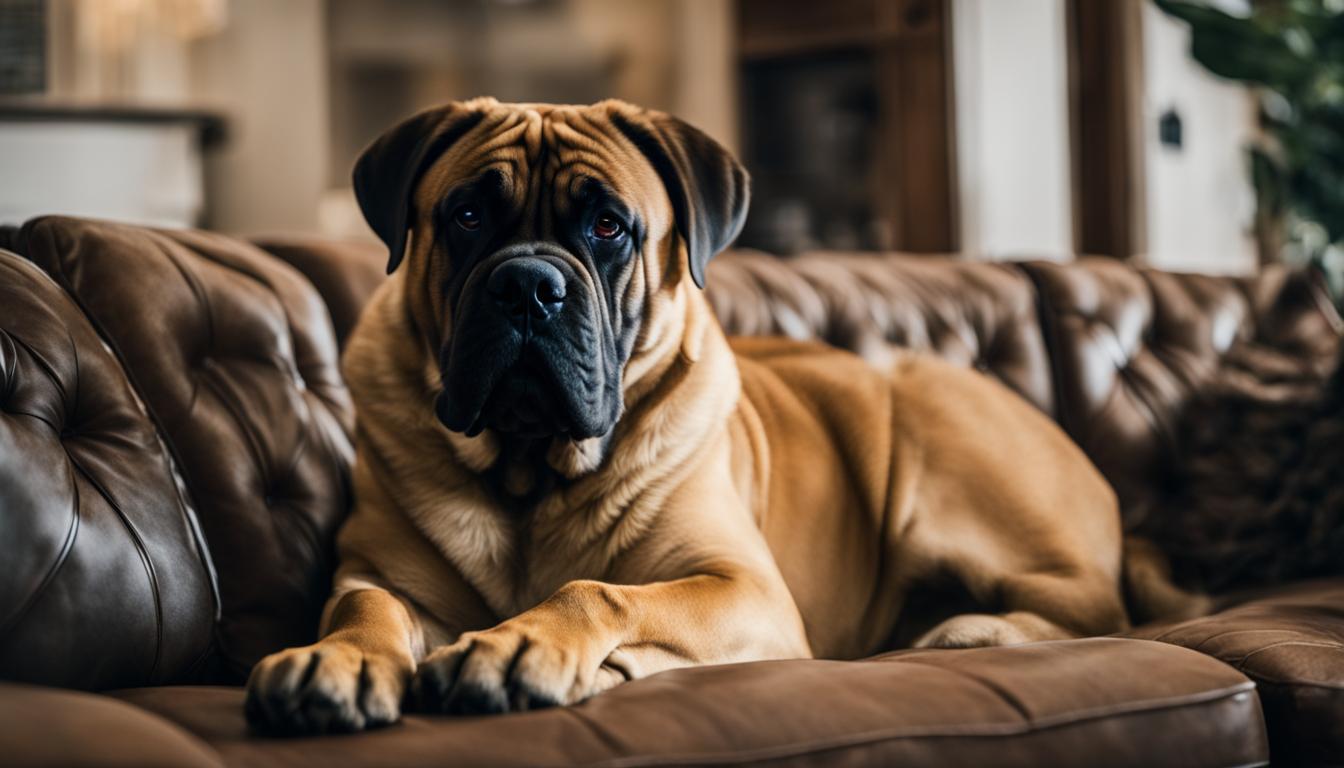Bullmastiffs are often viewed as lazy dogs, but this assessment depends on age, health, and personality. To gauge their proper level of laziness, let’s examine their distinctive traits and temperament.
The Origins and Characteristics of Bullmastiffs
Bullmastiffs are a unique breed of dog that originated in England in the 19th century. They were created by crossing Bulldogs with Mastiffs to create a powerful and protective breed.
Bullmastiffs were specifically bred to guard game estates from poachers, showcasing their instincts to protect and defend.
These dogs have distinct physical characteristics that make them easily recognizable. They have a square-shaped muzzle a short and straight coat, and come in various colors such as brindle, red-brown, and fawn. Bullmastiffs are large, with an average weight ranging from 100 to 130 pounds and a 25 to 27 inches height.
It’s important to note that Bullmastiffs have a moderate lifespan of 8 to 10 years. While they may have a shorter life expectancy than other breeds, their loyal and gentle nature makes them beloved companions for many dog owners.
| Characteristics | Description |
|---|---|
| Size | Large, weighing 100-130 pounds |
| Coat | Short and straight, various colors |
| Lifespan | 8-10 years |
| Temperament | Loyal, protective, gentle |
The Personality Traits of Bullmastiffs
Bullmastiffs are recognized for their gentle and affectionate demeanor. Though they possess a natural protective instinct and may be cautious around strangers, they become loving and loyal family companions with proper training and socialization.
They are brave, independent, and confident, making them reliable guard dogs. Bullmastiffs are also known for their affection towards their owners and relaxed demeanor in familiar environments.
Temperament
Bullmastiffs have a laid-back, easygoing temperament that sets them apart from other breeds. They are not typically high-energy dogs and are content with moderate exercise and relaxation.
Bullmastiffs are excellent companions for creating a calm and peaceful home. Their composed nature makes them an excellent fit for individuals or families seeking a relaxed environment.
Protective Instinct
Bullmastiffs have a strong protective instinct towards their family members. They are naturally wary of strangers and will act as a deterrent to potential threats.
Their imposing size and deep bark make them an effective deterrent, but they are not naturally aggressive.
Loyalty and Devotion
One of the most endearing traits of Bullmastiffs is their unwavering loyalty and devotion to their owners. They form strong bonds with their families and thrive on human companionship.
Exercise and Space Requirements for Bullmastiffs
Although often perceived as lazy dogs, bullmastiffs require regular exercise to maintain their physical and mental well-being.
Daily walks and at least one hour of daily activity are recommended to meet their exercise needs. Engaging in playtime activities such as fetching or interactive toys can also stimulate these low-energy dogs mentally.
When it comes to living spaces, Bullmastiffs can adapt to different environments, including apartments. However, they thrive best in homes with a backyard with sufficient space to move around.
A secure yard allows them to explore, stretch their legs, and enjoy outdoor time. It’s important to note that exercise should be provided in a controlled environment to prevent any potential injuries, as Bullmastiffs are prone to certain joint and bone diseases.
| Exercise Requirements | Living Space Requirements |
|---|---|
|
|
Training and Care for Bullmastiffs
To keep Bullmastiffs happy and healthy, they need consistent and firm training, preferably from someone experienced. Use positive reinforcement, and make sure they meet different people and animals early to feel comfortable.
A well-trained Bullmastiff makes a great family companion. Start obedience training when they’re young and continue it throughout their lives to encourage good behavior and discourage bad habits.
Grooming Bullmastiffs is easy. Just brush their short coat weekly to remove loose hair and keep it tidy. Bath them now and then to keep their skin and coat healthy. Regularly trim their nails, clean their ears, and care their teeth.
Because Bullmastiffs can have health issues, visiting the vet regularly is crucial. Keep up with vaccinations and parasite control to keep them in good shape.
Maintain their well-being by providing a proper diet and exercise. Even though they’re low-energy, they still need regular walks and playtime in a secure yard to stay fit.
Be cautious in hot weather to avoid overexertion, as Bullmastiffs can be sensitive to heat. Provide large breeds with a well-balanced diet to meet their nutritional requirements and keep them at a healthy weight.
Training Tips for Bullmastiffs
- Begin teaching your Bullmastiff good behaviors and social skills from a young age.
- Encourage your Bullmastiff using positive methods like rewards and praise to keep them motivated.
- Stay consistent by establishing clear rules and boundaries and enforcing them consistently.
- Expose your Bullmastiff to various environments, people, and animals to help them feel at ease in different situations.
- Consider enrolling your Bullmastiff in obedience classes or working with a professional dog trainer if you need help with specific training goals.
Potential Challenges of Owning a Bullmastiff

Bullmastiff Behavior
Bullmastiffs may exhibit stubbornness and strong-willed behavior, which can sometimes be challenging. They are independent dogs that require a confident owner who can provide consistent training and assertive leadership.
Early socialization is crucial to ensure they are comfortable around different people and animals, as this can help address any behavior issues before they become problematic.
Bullmastiff Health Problems
Like many large breeds, Bullmastiffs can be prone to specific health problems. These can include bone and joint diseases such as hip and elbow dysplasia, as well as heart conditions and certain types of cancer.
It’s essential for owners to be prepared for potential veterinary expenses and to provide their Bullmastiff with regular check-ups and preventative care to maintain their overall health and well-being.
Bullmastiffs as Family Pets
Bullmastiffs can make excellent family pets, especially in households with older children. Their loyal and protective nature makes them ideal companions for families seeking a devoted and watchful dog. However, it’s essential to consider a few factors when introducing a Bullmastiff into a family environment.
Supervision and Socialization
While Bullmastiffs are great with older children, supervision is recommended when they interact with younger children due to their large size.
Accidental knocks or falls can occur, so creating a safe environment for the dog and children is essential. Early socialization with children is crucial to help Bullmastiffs become comfortable around young ones.
Training and Exercise
Proper training and exercise are essential for Bullmastiffs to thrive in a family setting. They respond well to positive reinforcement methods and require consistent training from an experienced owner.
Adequate exercise, such as daily walks and playtime, helps maintain their physical and mental well-being. Providing mental stimulation through interactive toys and games also benefits this intelligent breed.
| Pros | Cons |
|---|---|
| Bullmastiffs are loyal and protective, making them excellent family guardians. | Due to their large size, supervision is recommended when they interact with young children. |
| They have a calm and gentle temperament, which is well-suited for family life. | Bullmastiffs require consistent training and socialization to prevent behavior issues. |
| They form strong bonds with their human family members and are generally patient with children. | Proper exercise and mental stimulation are necessary to prevent boredom and maintain well-being. |
Is the Bullmastiff the Right Dog for You?
Owning a Bullmastiff is a commitment that requires time, effort, and patience. Before bringing a Bullmastiff into your home, it’s essential to consider if this breed is the right fit for you and your lifestyle.
Bullmastiffs have a unique temperament that may not suit every household. While they are known for their loyalty and protective nature, they can also exhibit stubbornness and strong-willed behavior. Therefore, they are best suited for experienced owners with the knowledge and skills to provide consistent training and assertive leadership.
Proper care is also essential for Bullmastiffs. They require regular exercise to maintain their physical and mental well-being. Daily walks and playtime are necessary to prevent boredom and a secure yard or access to open spaces.
Grooming requirements for Bullmastiffs are relatively low, but regular brushing and occasional baths are recommended.
FAQ
Are Bullmastiffs lazy dogs?
Bullmastiffs are usually calm but need regular exercise to stay happy and healthy.
What are the origins and characteristics of Bullmastiffs?
Bullmastiffs are a crossbreed between Bulldogs and Mastiffs, originating in England in the 19th century. They were bred as protective dogs for gameland properties.
These dogs have a square, wrinkled muzzle, a short and straight coat, and come in various colors. They are large, with an average weight of 100-130 pounds and a height of 25-27 inches. Bullmastiffs have a moderate lifespan of 8-10 years.
What are the exercise and space requirements for Bullmastiffs?
Bullmastiffs have moderate energy levels and require regular exercise to stay healthy. Daily walks and at least one hour of daily activity, such as playtime in a secure yard, are recommended.
They can adapt to different living spaces but are best suited for homes with a backyard where they can have sufficient space to move around. However, they can also live in apartments if they receive proper exercise and mental stimulation.
What are the training and care requirements for Bullmastiffs?
Bullmastiffs thrive with consistent, positive training and early socialization. Grooming is easy, requiring weekly brushing and occasional baths. Prioritize dental care, vet check-ups, a balanced diet, and regular exercise to keep them healthy and fit.
What are the potential challenges of owning a Bullmastiff?
Bullmastiffs can be prone to specific health issues, including bone and joint diseases, and they have a shorter lifespan than other breeds.
They may also exhibit stubbornness and strong-willed behavior, requiring a confident owner who can provide consistent training and assertive leadership. Addressing any behavior issues early on is essential to prevent them from becoming problematic.
Are Bullmastiffs good family pets?
Bullmastiffs make great family pets, especially with older kids. They’re loyal and protective, but due to their size, supervise interactions with young children to prevent accidents. Early socialization and exposure to various environments help them become well-rounded, confident dogs.
Is the Bullmastiff the right dog for me?
Owning a Bullmastiff is a commitment that requires time, effort, and patience. They are unsuitable for every household, and potential owners should thoroughly research the breed and consider their lifestyle and capabilities.
Bullmastiffs are best suited for experienced owners who can provide consistent training proper socialization and meet their exercise and care requirements.
